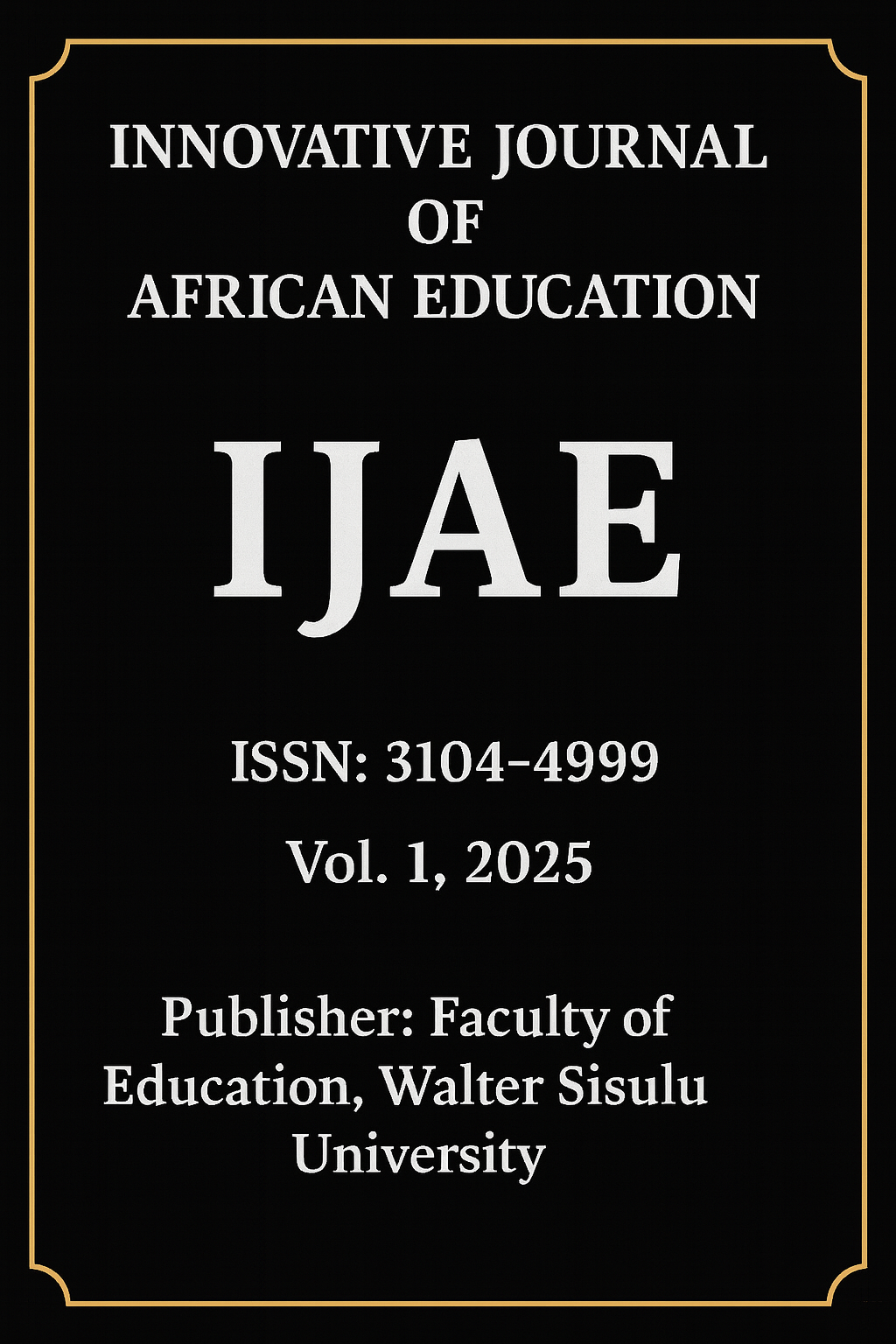Student Perceptions of Utilisation of Learning Management Systems and Blended Learning
Keywords:
Moodle, blended learning, technology acceptance model, digital literacy, learning management systemsAbstract
This study explores university students’ perceptions of Moodle and blended learning at a selected South African university, using on the Technology Acceptance Model (TAM). Given the rapid adoption of Learning Management Systems (LMS) in higher education, especially in digitally disadvantaged settings, understanding students' attitudes towards Moodle’s usefulness, ease of use, and overall intentions to engage with e-learning platforms is crucial. Using a cross-sectional survey design, data were collected from 834 students of level one to honours via an online Likert-scale questionnaire, and results were analysed descriptively. Findings indicate that students generally perceive Moodle as a useful and accessible tool, particularly for accessing course materials and enhancing the learning experience. However, many first-year students experience digital literacy challenges, highlighting a need for targeted interventions. The study’s implications suggest that historically disadvantaged universities could enhance student engagement and academic success by offering tailored digital support and refining LMS integration strategies. These insights contribute to a broader understanding of the digital divide and underscore the need for inclusive educational technology practices in higher education.
References
Afolabi, O. S., & Ajani, O. A. (2023). South African rural students’ adoption and use of learning management systems. International Journal of Research in Business and Social Science (2147-4478), 12(4), 410–421. https://doi.org/10.20525/ijrbs.v12i4.2521
Cilliers, L., Ntlabathi, S., & Makhetha, P. (2017). A user study about the usage of a learning management system in a South African university (pp. 38–42). https://doi.org/10.1007/978-3-319-71084-6_5
Croasmun, J. T. (2011). Using Likert-type scales in the social sciences. Journal of Adult Education, 40(1), 19–22.
Cronje, J. C. (2020). Towards a new definition of blended learning. Electronic Journal of E-Learning, 18(2), 114–121. https://doi.org/10.34190/EJEL.20.18.2.001
Cronje, J. C. (2022). From face-to-face to distance: Towards flexibility in five dimensions of blended learning—Lessons learnt from the COVID-19 pandemic. Electronic Journal of E-Learning, 20(4), 436–450. https://doi.org/10.34190/ejel.20.4.2201
Darnton, G. (2023). Likert scales and questions: Uses and abuses. European Conference on Research Methodology for Business and Management Studies, 22(1), 44–49. https://doi.org/10.34190/ecrm.22.1.1748
Davis, F. D. (1989). Perceived usefulness, perceived ease of use, and user acceptance of information technology. MIS Quarterly, 13(3), 319–340. https://doi.org/10.2307/249008
Gamede, B. T., Ajani, O. A., & Afolabi, O. S. (2021). Exploring the adoption and usage of learning management system as alternative for curriculum delivery in South African higher education institutions during COVID-19 lockdown. International Journal of Higher Education, 11(1), 71–83. https://doi.org/10.5430/ijhe.v11n1p71
Hameed, S. Q., & Hasan, H. S. (2021). Learning management system developments and challenges: A literature review. Mesopotamian Journal of Computer Science, 2021(5), 35–43. https://doi.org/10.58496/MJCSC/2021/005
Hassan, A., Abdullahi, A., & Garba, A. (2022). A systematic review of the role of learning management systems in virtual classroom instructions delivery, management, and evaluation in tertiary institutions. Majassu Journal, 5(1). https://majassu.com/volume-5-number-1-june-2022/
Hiasat, L. (2021). Blended learning. In Handbook of Research on Barriers for Teaching 21st-Century Competencies and the Impact of Digitalization (pp. 17–22). https://doi.org/10.1007/978-3-030-79143-8_3
Jantjies, M., & Dalasile, V. (2019). Digital literacy amongst first year university students from under-resourced schools. Journal of Education, 76, 44–60.
Lukose, J. M., Kantore, A., & Fosu, A. (2021). Students’ readiness for using e-learning in South African rural universities: A case of Walter Sisulu University. Global Conference on Business and Social Sciences Proceedings, 12(1), 100. https://doi.org/10.35609/gcbssproceeding.2021.12(100)
Moonsamy, D., & Govender, I. (2018). Use of Blackboard Learning Management System: An empirical study of staff behavior at a South African university. EURASIA Journal of Mathematics, Science and Technology Education, 14(7), 2817–2829. https://doi.org/10.29333/ejmste/91623
Mugo, D., Njagi, K., Chemwei, B., & Motanya, J. (2017). The technology acceptance model (TAM) and its application to the utilization of mobile learning technologies. British Journal of Mathematics & Computer Science, 20(4), 1–8. https://doi.org/10.9734/bjmcs/2017/29015
Napitupulu, D., Abdel Kadar, J., & Kartika Jati, R. (2017). Validity testing of technology acceptance model based on factor analysis approach. Indonesian Journal of Electrical Engineering and Computer Science, 5(3), 697–704. https://doi.org/10.11591/ijeecs.v5.i3.pp697-704
Nemoto, T., & Beglar, D. (2014). Developing Likert-scale questionnaires. Tokyo University of Foreign Studies Research Reports, 2, 1–12.
Oyedemi, T., & Mogano, S. (2018). The digitally disadvantaged: Access to digital communication technologies among first-year students at a rural South African university. Africa Education Review, 15(1), 175–191. https://doi.org/10.1080/18146627.2016.1264866
Prince, M.-A. E., & Ade-Ibijola, A. (2023). A comparative analysis of shared technological mobile facilities in Africa. SSRN Electronic Journal. https://doi.org/10.2139/ssrn.4331731
Procter, C. (2003). Blended learning in practice. Education in a Changing Environment Conference Proceedings, 1–7. https://api.semanticscholar.org/CorpusID:263028867
Sharma, M., & Srivastav, G. (2020). Study and review of learning management system software. In Advances in Intelligent Systems and Computing (pp. 373–383). https://doi.org/10.1007/978-981-15-2043-3_42
South, L., Saffo, D., Vitek, O., Dunne, C., & Borkin, M. A. (2022). Effective use of Likert scales in visualization evaluations: A systematic review. Computer Graphics Forum, 41(3), 43–55. https://doi.org/10.1111/cgf.14521
Tahar, A., Riyadh, H. A., Sofyani, H., & Purnomo, W. E. (2020). Perceived ease of use, perceived usefulness, perceived security and intention to use e-filing: The role of technology readiness. Journal of Asian Finance, Economics and Business, 7(9), 537–547. https://doi.org/10.13106/JAFEB.2020.VOL7.NO9.537
Timmis, S., & Muhuro, P. (2019). De-coding or de-colonising the technocratic university? Rural students’ digital transitions to South African higher education. Learning, Media and Technology, 44(3), 252–266. https://doi.org/10.1080/17439884.2019.1623250
Tripathi, R. N. (2022). Review of learning management system in current scenario. Indian Journal of Computer Science, 7(6), 29–34. https://doi.org/10.17010/ijcs/2022/v7/i6/172622
Walter Sisulu University. (2021). Teaching and learning strategy 2021–2026. https://www.wsu.ac.za/images/WSU-Teaching-and-Learning-Strategy.pdf
Weerasinghe, S., & Hindagolla, M. (2017). Technology Acceptance Model in the domains of LIS and education: A review of selected literature. Library Philosophy and Practice (e-journal). http://digitalcommons.unl.edu/libphilprac/1582
Downloads
Published
Issue
Section
License
Copyright (c) 2025 Tshepo Rabotapi, Zanoxolo Dlamini, Zikhona Macibela, Sanele Mpisi, Minentle Nkebane (Author)

This work is licensed under a Creative Commons Attribution 4.0 International License.





